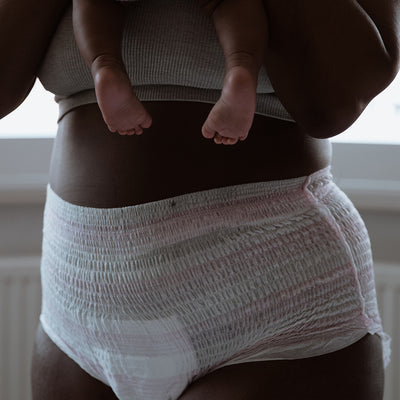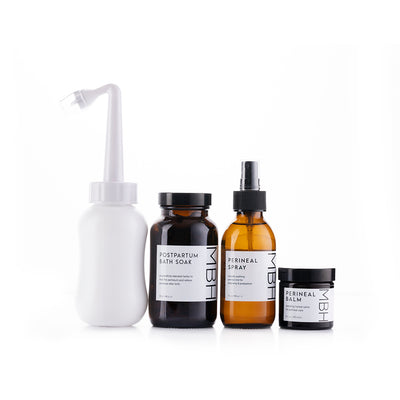Perineal Care: Tears and stitches after birth

No one likes to talk about it, but the state of your vagina after childbirth can be rough. Many women experience tears to some extent during childbirth as the baby stretches the vagina. Most occur in the perineum (the area between the vagina and anus) and over 85% of women in the UK who deliver vaginally sustain some degree of perineal trauma, many requiring stitches
Tears can fall into roughly three categories;
-
First-degree - to the skin of the vagina and perineum, which heals naturally
-
Second-degree - to the skin and muscle beneath, which may require stitches
-
Third and fourth-degree - all the way to the anus and muscles beneath, these tend to be rare cases, the overall rate is 2.9% in the UK, slightly higher in first-time mothers.
Tears can happen for multiple reasons, mostly due to the size, position, and speed of the baby coming out and whether or not you tear is usually out of your control. However, there are ways to prevent or mitigate tears.
One of the best things you can do to help prevent perineal tearing is perineal massages towards the end of pregnancy to help the muscle and skin to stretch more easily during birth. Studies have shown that perineal massage can help reduce tearing.
Your midwife can help to protect your perineum during birth by applying a warm compress as your baby’s head is crowning. This is something you can discuss with them and you can also include your wish for this to be done to your birth plan.
Your midwife may also perform an episiotomy to reduce the chance of tearing or to make a third- or fourth-degree tear less likely.
If you do tear during birth, you probably won’t feel it happen – as contractions and the baby crowning are pretty intense sensations. If it’s just small tears you might not need stitches, but if you do need to have stitches, you would be given a local anaesthetic so you won’t feel them.
Recovery can be rough as the area will be quite sore and as it heals your stitches might be tight and itchy. Including our top 4 tips into your postpartum routine can help make recovery a bit easier.
DITCH THE TOILET PAPER
Regular toilet paper might be really uncomfortable to use on your swollen, stitched-up perineum. So for the first few weeks after childbirth, your peri bottle will be your best friend. Our Upside Down Peri Bottle is designed with an angled neck to make reaching the area a bit easier. The water comes out with gentle precision and gives you a continuous stream for efficient cleansing. Use it every time you go to the bathroom to keep your wound clean and infection-free.
COLD THERAPY
Cold packs are a must-have for your postpartum self-care because cold therapy helps soothe the pain and irritation 'down there' after birth. Aside from the stitches, you’re going to have some pretty significant swelling in the vaginal area after childbirth. This is normal but also painful and uncomfortable. You can use an ice pack or try making padsicle which is essentially a homemade cold pack - it is a frozen maternity pad filled with healing goodness that you put on your lady bits after birth. If you have vaginal swelling this is basically the most cooling and soothing thing your vagina may encounter during the healing process.
THE MAGIC OF WITCH HAZEL
Witch Hazel is a great way to get some relief from perineal swelling and haemorrhoids and will be your best friend during your postpartum recovery. It’s an herbal skin soothing remedy with tannins and oils that can help reduce inflammation. Plus it has great wound healing properties which makes it an ideal remedy for reducing vaginal swelling and swelling of haemorrhoids.
Here are our favorite ways to use Witch Hazel for your wound and stitches care:
-
A few generous sprays of Witch Hazel Perineal Spray directly on your perineum or on top of your pad can provide immediate relief from pain, itching, and swelling, while also promoting tissue healing.
-
Cotton pads that are soaked with a witch hazel solution can be layered on your maternity pads or folded and tucked into the folds of your bottom so they are directly in contact with the sore spot to relieve pain from hemorrhoids and postpartum swelling. Try these DIY Soothing Witch Hazel Pads.
GIVE YOURSELF A GOOD SOAK
Sitz baths are one of our favourite postpartum recovery tips. It is essentially a warm, shallow bath or sitz pan with an Herbal Bath Soak or Epsom salt soak which can feel like the ultimate relief once you’ve given birth. Not only is it soothing it can also encourage the healing process, increase your circulation, reduce swelling, cleans the area so there’s less risk of infection, and ease itching. Sitz baths are also a great remedy for painful, itchy hemorrhoids.




Hello I’m Hina Azmat speaking biscally I m namal delivery I have cut and sitch inside outside my sex vagina to too tight when I have sex my husband penis not going inside
Leave a comment